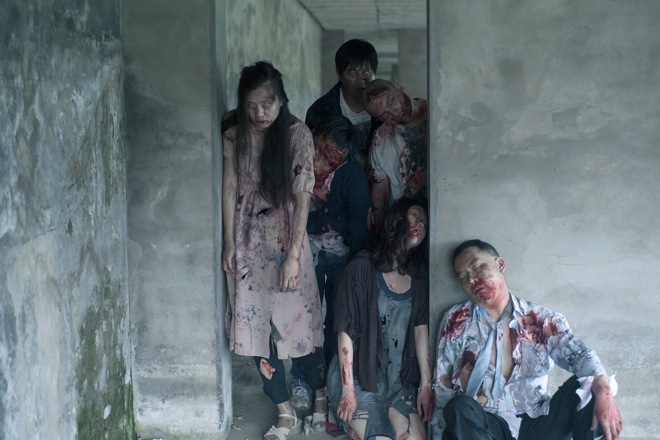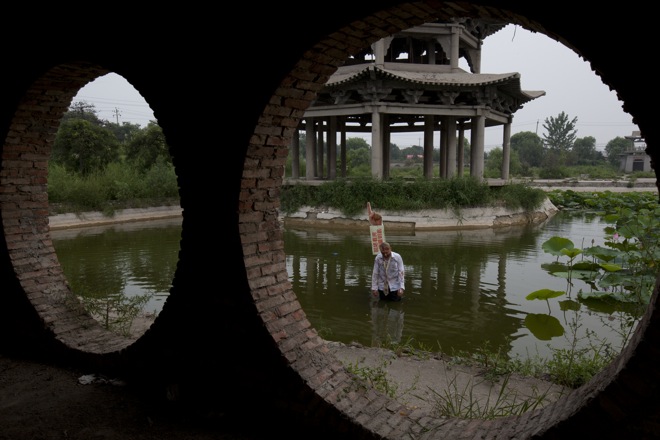“…to me you are the fog the rain and the wind, come and go, in the end nothing was left behind…”
—from “Haze and Fog” (2013)
In May 2012, at the final edition of ARTHK (Hong Kong International Art Fair; now Art Basel Hong Kong), the curated project and book The future will be…China. Thoughts on What’s to Come by Hans Ulrich Obrist was launched. At the time, I didn’t think a whole lot about the textual sound bites, images and interpretations, along with responses from Chinese artists to the sentence “The future will be…,” as I leafed through its coarse red, yellow and monochromatic newspaper, zine-like pages. That was, until I came to write this reflection on Cao Fei‘s (b. 1978) latest film—“Haze and Fog”(2013) which was on show at the Centre for Chinese Contemporary Art (CFCCA) in Manchester where, since October 2012, I am Research Curator on a part-time basis.
Cao Fei’s contribution to the publication stands out from the bilingual Mandarin-English text-heavy majority as she responded with a photograph, a reproduction of a promotional poster for the popularized American TV series The Walking Dead. The ink from the black and white image of a lone ranger seen riding a horse on a desolate highway into the unknown city skyline ahead bleeds to the page edge. Culture and location undefinable, and interpretive text unstated; you are unclear of the artist’s intention only knowing—if you are familiar with the show—the contexts of the poster. The series follows a sheriff’s deputy, who had recently awoken from a coma, negotiating a post-apocalyptic world dominated by zombies. Premiered in November 2010 in the USA, it is now in its fourth season and watched globally, including in China where it is aired through Youku, China’s YouTube, becoming the nation’s most-watched season of Western television with over 27 million views trending on Weibo, China’s Twitter, as “行尸走肉” (xíngshī zǒuròu)—“Traveling Corpses, Walking Meat.”
While ghosts and mythical realities of death have been present in symbolic forms or otherwise within Chinese scroll paintings and literature for centuries, the specific notion of the “zombie” has only more recently been referenced within Chinese contemporary culture, influenced by these Western representations of the “walking dead” (it must be noted, however, there is also the traditional lore around the jiangshi, the undead corpse). Through this “lone” image, Cao Fei was commenting on a specific moment within popular culture, providing a gateway into a new world, a mirror into another distorted and constructed reality, concepts renowned as part of her multi-media installation and digital to video practice. Unknown to her audience, she was also giving a clear visual clue, a thought into a new artistic concept in progress—questioning the paradox between life and death, and how we define those as dead or as alive—an insight into her next unrealized world that would bring her to make “Haze and Fog”(2013).
This new commission is based on the artist’s novel writings and is her only work of fiction, set in what is a supposed modern metropolis, some of China’s largest sprawling cities, depicting slowly, intimately, and in detail, the routine struggles of day-to-day life and personal relationships of the middle classes. Usually unnoticed, here they are the main character represented en masse as a powerless, neutral and emotionless force frozen, as if a “zombie,” in time, alongside the parallel realities of the upper classes and lower subcultures.
As scenes play out you become more and more the voyeur, observing partial reality, partial insanity, partial absurdity, double and changing identities, characters that are repeatedly viewed as multiple story lines unfold in a literal and somewhat confusing “haze.” There is a character to which we can each make an association—the pregnant housewife cutting off her finger with no emotion as she cooks dinner, a man delivering a box of what seem like watermelons when they are in fact bouncy balls, a young girl changing into a stripper outfit in a stairwell, a man cracking an egg on a glass-topped table, an artist painting an illusionary visual cube on canvas, an out of tune singer heard from an apartment window, a man playing snap with a collection of call girl cards, an aroused security guard peeking through partially open blinds to watch a couple’s intimacies, a group of estate agents playing in a newly built playground devoid of expression, a woman obsessively cleaning the windows of a dental office, an ayi [domestic helper] pulling a wheelie rubbish bin behind her on the street only to come across an iridescent male peacock in full plume.
The final scenes conclude with the presence of “real” blood-covered, partially mutilated, leg-dragging zombies who represent the “living” in the film, who come to feed from the flesh of, and thus awaken, the bored, the numb, the lifeless, the thoughtless, the painless, the already dead, the people en masse. It is the estate agents who are the gatekeepers between the zombie fiction and the mortal reality; they choose the prey from which the “real” zombies feed—furthermore, making reference to the rapid changes of architectural development in China and a drive for an urban utopian perfection.
A purposeful lack of color and opaque clarity to the film builds a quiet sensitivity to how sex or sexual pleasure, harm or self-harm does not even have the power to arouse appropriate emotion, also echoing how a city is seen for the first time—such as viewing the skyline from a taxi cab window often frozen in awe of the unseen and unknown. Furthermore, being largely a silent articulation with limited verbal narrative, understanding is therefore primarily reliant on the film’s visual strength and clarity. Short injections of soundtrack provide another layer of context, including well-known Latin melodies, traditional Chinese folk music translated with discrete subtitles, and newly composed piano score to give “a sense of sadness and craziness, of mixed emotion”—another chance to break from the “haze” and “fog.” These musical interludes twinned with ritualistic movement and action on-screen provide another humorous subplot to the film that also links to the often absurd imagery and props on screen.
A further and obvious interpretation is that Cao Fei is making reference to China’s constant battle with pollution, which has recently been at unprecedented levels, as characters are seen wearing face masks or bathing to remove the murky airborne “fog” of industrial and societal dirt that on a near daily basis layers the skyline, clinging to your skin and lungs. Ironically, since my days of living in China, it has awoken my gaze to the beauty and clarity of a clear blue sky that I now get lost in and silenced by, as do the characters within the film.
“Haze and Fog”(2013) was premiered in a solo exhibition at Eastside Projects, Birmingham (UK) at the end of September 2013, then screened across multiple venues across the UK including Tate Modern, London, and Arnolfini, Bristol, with a further exhibition at Centre for Chinese Contemporary Art (CFCCA), Manchester. This sporadic placement of the film in different UK localities immediately made you question each city, and your purpose in it, through Cao Fei’s eyes—“a moment for on-going global discovery”—acting as a tool to question your existence, your reality, your fears, your place in the world, a clarifying act as such with a potential to acknowledge the now and make change happen. Also, it brings to the fore a global state of mind, indicative of a lack of engagement with and association to the reality of life, the comfort of the security blanket of life, the fact that you can be anyone or anything and still feel the same feeling wherever you are in the world, still feel an emptiness at the end of a day, or a confusion of not knowing how you feel. It also references the simplicity of life, satisfying for some, but a battle for others.
The film has attracted mixed reaction from viewers, including those embracing the zombie phenomenon, feeding from its urban and societal dramatic representations, to those disgusted by an apparent misguided vision of China. This latter issue is another underlying statement presented within the film where the “walking dead” could be seen to portray a censored China and Chinese voice.
Presented in collaboration with the Eastside Projects exhibition was Cao Fei’s “House of Treasures”(2013), initially commissioned for the Mobile M+ series exhibition “Inflation!,” a city intervention project of large inflatable sculptures that took over the West Kowloon district of Hong Kong in spring/summer 2013. In Birmingham (UK), Cao Fei’s giant suckling pig was installed in the interior atrium space of Millennium Point, a multi-functional media venue peripheral to the city centre that serves as a thoroughfare go-between the local university, Thinktank Museum, IMAX cinema and office spaces. Its absurd placement in the building’s metallic interior made it feel like a caged animal, and as I was getting inside the insides of “House of Treasures”(2013) my mind was torn between its interpretations in Hong Kong and UK, and whether it could ever be translated and understood in UK terms due to the many complex Chinese cultural references. On show inside were multi-dimensional screenings of Cao Fei’s prolific digital and video work “RMB City” (launched in 2008), factions of the global interactive online “Second Life” platform that present a constructed virtual world in form of a petropolis, a new floating frontier city formed from their inherent natural resources which could be seen as “something between apotheosis and apocalypse. Its positive and negative. Its optimistic and pessimistic. Its apocalyptic and apotheotic,” a statement that further resonates through her latest film.
In Chinese terms, “Zombie” has become a Western ghost and, in this sense, echoed as a shadow concept throughout the film where the “walking dead” representation of the “real” zombies, seen fleeting on screen, are an almost gestural transcultural reference. From the serious to humorous, the voyeuristic to observed, the real to the imagined, “Haze and Fog”(2013) presents another collective identity of China today by commenting on the rapid construction of the contemporary metropolis, specifically the want of a city utopia, in friction with negotiating this modern-day necropolis, a 21st Century “city of the dead.” Is it feeding time? Or is it time to be awakened?
[The works of Cao Fei cited here mark new initiatives within the UK, specifically “House of Treasures”(2013) for the new Arts Strategy at Millennium Point, Birmingham (UK), and “Haze and Fog”(2013) as the first artwork acquired for the ‘New Contemporary Chinese Art Collection’, the first collection of its kind in the UK created in partnership with Centre for Chinese Contemporary Art (CFCCA) (UK) and University of Salford (UK). The film was produced with Eastside Projects (UK) and Vitamin Creative Space (China), and co-commissioned by Centre for Chinese Contemporary Art (CFCCA) (UK), Eastside Projects (UK), Arnolfini (UK), Bath School of Art and Design and Bath Spa University (UK)]

